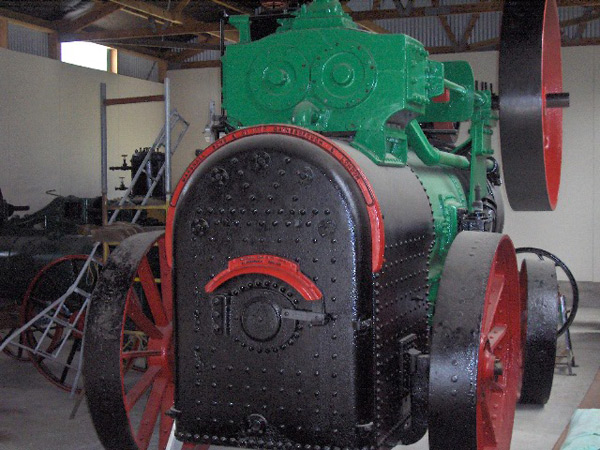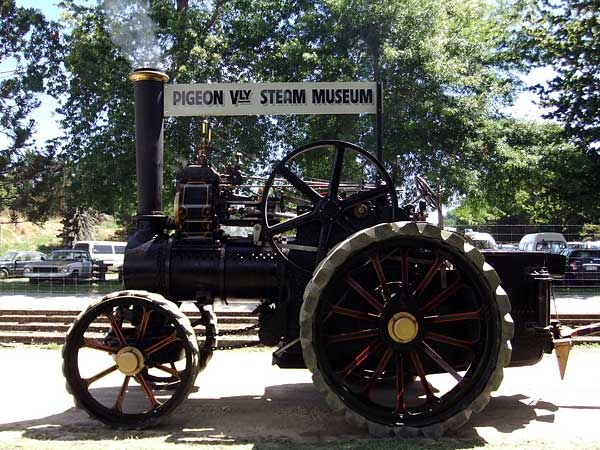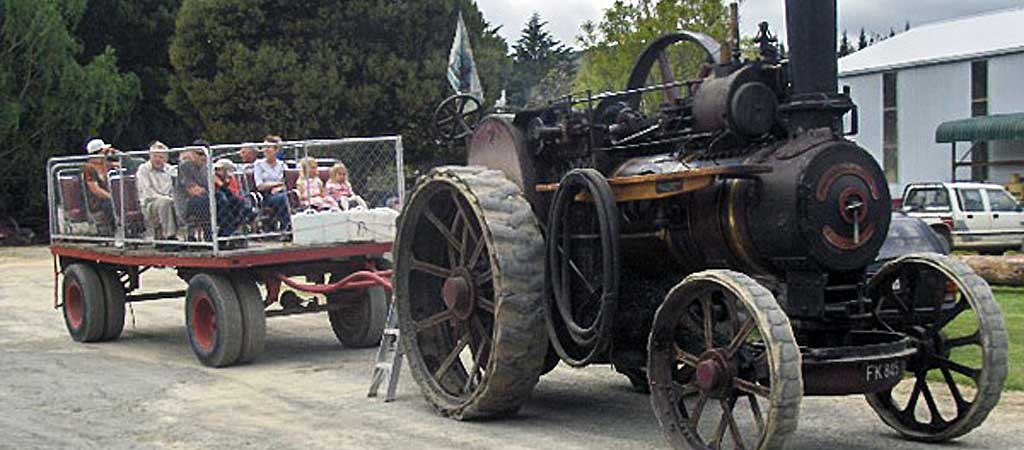The Higgins Heritage Park Story
In the beginning:
Ross Higgins, a local farmer, had a concept of a private Steam Museum which was borne out of a life-long respect and love for steam machinery. This grew from working at his Grandfather’s mill in the Ronga Valley, Rai Valley, Marlborough.
Ross and others first mooted building a sawmill in 1970. A possible Government grant of $250,000 was an inspiration however this was not to be. Other approaches to council and businesses also failed. In 1973 Ross Higgins and John Christian, a retired sawmiller decided to build a replica of a 1920’s sawmill on Ross’s property in Pigeon Valley. The mill was powered by an IHC WD40 diesel bulldozer engine until 1974. Unfortunately by 1980 John’s eyesight was failing and he handed the entire operation over to Ross. The diesel engine failed in 1981 and was irreparable. In 1984 Ross purchased for $10,000 a 1906 10HP Marshall portable steam mill engine and converted the mill to steam power using a plan from Brownlee’s 1876 Havelock Mill.
The counter shaft was designed by Kelvin Cochrane, a chief engineer, and supported by beams from the Waiau Bridge which was donated by Duncan Rutherford. Other materials came from the Waitaki Picton freezing works.
Unfortunately the Marshall appeared to lack power – it was suggested that this was the reason steam had been replaced by electricity 50 years previously. Ross persevered and refurbished the Marshall and with the aid of pulley belts from Brownlee’s Rau Rau mill, saved the display of a sawmill powered by a steam engine which linked to the early development in New Zealand’s history.
The regulations and subsequence expense now make it prohibitive for the sawmill to operate by steam.
Other Steam Attractions include:
“Betsy”
A stationary portable steam engine, a huge old Marshall, had been discovered in 1977 at Rahui in the Buller Gorge. In November of 1977 a group of enthusiasts armed with a HD6 crawler tractor proceeded to try to load the Marshall onto a sledge. All went reasonably well until “Betsy”, as she has been named, slid into a swamp. The tractor ran out of fuel trying to recover her and the attempt was abandoned until 1978. Betsy” weighed in at 10 ton.
Ross, cousin Ron and a crew returned to Rahui and this time triumphantly managed to recover a tonne of steam treasures, making 11 trips to load for transportation on a UB railway wagon.
In 1907 “Betsy” was the largest portable steam engine built by Marshalls of Gainsborough, England. It was an experimental with only 2 such engines built. The second engine was for the Murray River Paddle boat in Australia. “Betsy” is now located in the Higgins Heritage Park Lotto shed. She is reported to have regularly consumed 12 cord of wood per day. The full story in the book, “Rahui Awakening” is for sale in the museum shop.


Pigeon Valley Steam Organisation
An inaugural meeting of the museum enthusiasts was held at the Ocean Lodge, Tahunanui, Nelson in 1980. Those present were Ross Higgins as acting Chairman, Mrs Edna Higgins as acting secretary / Treasurer, Messrs Graham Allan, Syd Aydon, B.Gilbraith, Michael Higgins, Ken Hitchcock, Charlie James, Evan Moorhouse, Ken Morris, Graeme Nicholls, A.Nuttall, R.Nuttall, Norm Parkes, Tim Rainey, A.Ross, Duncan Rutherford, D.Thomas, Ron Higgins, Rex Gibbs, Arn Ahnfeldt, and Mesdames Diane Higgins, Lorna Gibbs and Elizabeth Ahnfeldt. Apologies were received from P.Knowles and R.Gibbs.
At this meeting the Rover Car Club was given permission to erect an old-time garage to be used as club rooms.
In 1981 at a Special Committee meeting, the property of approximately 6.5 acres was transferred to the Museum, free of charge, by Ross Higgins. A formal lease was also granted to the Rover Club.
Other Early Exhibits
The next major exhibit was the Tangye Winch which was donated by Les Hewetson of Ronga Valley. This winch powered a skyline, a unique attraction in the Southern Hemisphere which originally extended from the museum to the hilltop on the northern side. This project had been sponsored by H. Baigent & Sons and the NZ Forest Service. The Tangye winch system is used during logging demonstrations throughout the year although it has now been downsized for safety reasons.
In 1983 a Fowler Traction engine, originally operated in Tadmor but then sold to Fielding, was donated by the Chambers Family of Fielding. This was shipped to Nelson on board the Union Hobart. This is still in operation today at Higgins Heritage Park for our visitors to see.
Other steam engines in the steam collection have been donated / acquired and restored to working order, including:
- A Marshall engine from S. Kirkpatrick & Co Ltd
- A 1880 engine from the Anchor Foundry
- A2 cylinder vertical engine from the Picton Freezing works
- Engines manufactured by Bryan Donkin & Co
- The Tangye Steam Winch

See the Fowler steam traction engines, an 8hp and a 5hp, running on ‘steam-up days’
The 8hp engine was imported from South Africa about 1902 after service in Boer War. It spent its working life around the Nelson back country. In 1983 it was donated to Pigeon Valley by Mr and Mrs Chambers. It is used to tow a trailer giving rides, and occasionally powers a chaffcutter and a haybaler.
Costs of refurbishing and maintaining these items of yesteryear are a significant ongoing challenge.
Ross Higgins’ vision of saving old redundant steam machinery into a steam museum, is a foundation attraction of the current Higgins Heritage Park. Displays, open days and Field Days having been held since 1980.
The Park has now expanded around the steam nucleus and includes many other heritage collections. These are detailed on the “What to See & Do at Higgins Heritage Park” page.
